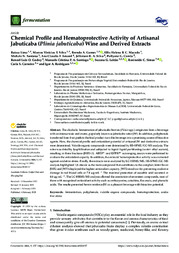Chemical Profile and Hematoprotective Activity of Artisanal Jabuticaba (Plinia jabuticaba) Wine and Derived Extracts.
Chemical Profile and Hematoprotective Activity of Artisanal Jabuticaba (Plinia jabuticaba) Wine and Derived Extracts.
Author(s): LIMA, R.; SILVA, M. V. T.; GOMES, B. A.; MACEDO, E. H. B. C.; SANTANA, M. N.; AMARAL, A. C. F.; SILVA, J. R. A.; CORRÊA, P. G.; GODOY, R. L. de O.; SANTIAGO, M. C. P. de A.; LEITÃO, S. G.; SIMAS, R. C.; CARNEIRO, C. S.; RODRIGUES, I. A.
Summary: The alcoholic fermentation of jabuticaba berries (Plinia spp.) originates from a beverage with an intense taste and aroma, popularly known as jabuticaba wine (JW). In addition, polyphenols transferred from fruit peels to the final product turn this beverage into a promising source of bioactive agents. Here, the chemical profile and antioxidant potential of artisanal JW and derivative extracts were determined. Volatile organic compounds were determined by HS-SPME/GC-MS analysis. The wine was dried by lyophilization and subjected to liquid-liquid partitioning (water: ethyl acetate), resulting in three fractions (JWF1-3). ABTS•+ and DPPH•+ scavenging assays were performed to evaluate the antioxidant capacity. In addition, the extracts’ hematoprotective activity was evaluated against oxidative stress. Finally, the extracts were analyzed by LC-HRMS/MS. HS-SPME/GC-MS analysis highlighted 1,8-cineole as the main compound that contributes to the camphor/mint flavor. JWF2 and JWF3 displayed the highest antioxidant capacity. JWF2 stood out for preventing oxidative damage in red blood cells at 7.8 ?g·mL?1 The maximal protection of ascorbic acid occurred at 8.8 ?g·mL?1. The LC-HRMS/MS analysis allowed the annotation of seventeen compounds, most of them with recognized antioxidant activity such as anthocyanins, catechins, flavanols, and phenolic acids. The results presented herein reinforce JW as a pleasant beverage with bioactive potential.
Publication year: 2023
Types of publication: Journal article
Unit: Embrapa Food Technology
Observation
Some of Embrapa's publications are published as ePub files. To read them, use or download one of the following free software options to your computer or mobile device. Android: Google Play Books; IOS: iBooks; Windows and Linux: Calibre.
Access other publications
Access the Agricultural Research Database (BDPA) to consult Embrapa's full library collection and records.
Visit Embrapa Bookstore to purchase books and other publications sold by Embrapa.

